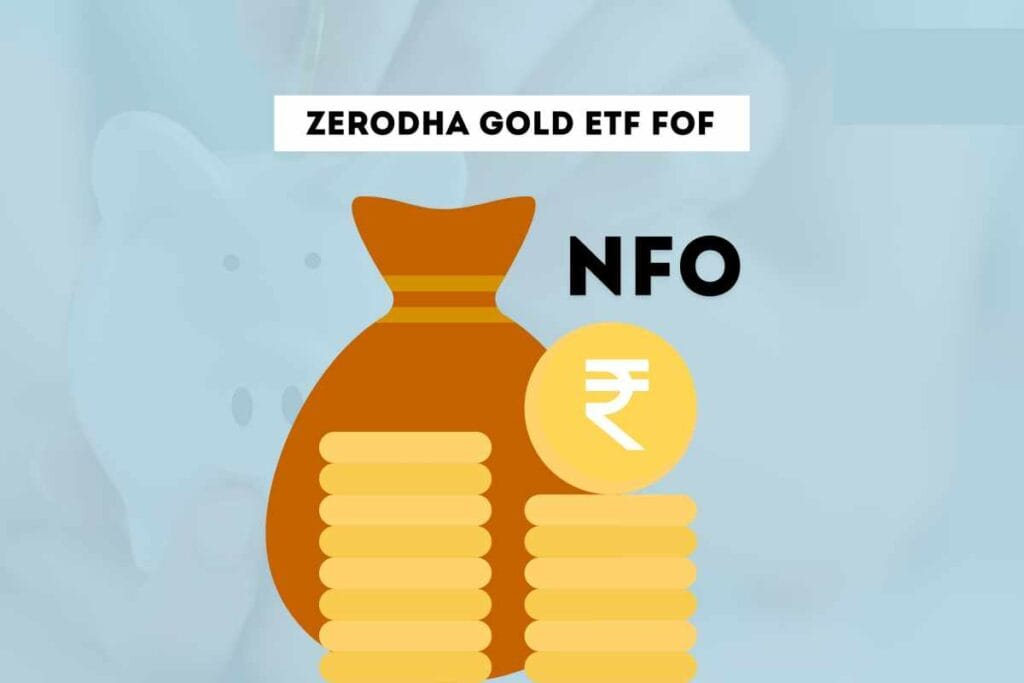The Zerodha Gold ETF, symbolized as GOLDCASE, is an exchange-traded fund designed to mirror the performance of gold prices. This ETF offers investors a straightforward and cost-effective method to incorporate gold into their investment portfolios without the complexities of owning, storing, or securing physical gold.
Key Details:
- Objective: To generate returns that correspond to the domestic price of gold, before accounting for expenses, subject to tracking errors.
- Holdings: As of January 19, 2025, the fund’s portfolio comprises 97.42% physical gold and 2.58% cash and cash equivalents.
- Expense Ratio: The fund maintains a low expense ratio of 0.31%, enhancing its cost-effectiveness for investors.
- Net Asset Value (NAV): The NAV is ₹12.5945 as of January 19, 2025.
- Asset Under Management (AUM): The fund manages assets totaling ₹147.59 crore.
- Risk Profile: The ETF is categorized as high risk, suitable for investors seeking long-term capital appreciation through exposure to gold.
Investment Considerations:
- Minimum Investment: Investors can begin with a minimum amount of ₹10, making it accessible for a wide range of investors.
Tax Implications:
- Short-Term Capital Gains (STCG): If units are sold within one year, gains are taxed according to the investor’s applicable tax slab, plus 4% cess and surcharge, if any.
- Long-Term Capital Gains (LTCG): For units held beyond one year, gains are taxed at 12.5% (plus applicable surcharge and 4% cess) starting from April 1, 2025.
Investment Philosophy:
The Zerodha Gold ETF is ideal for investors aiming to diversify their portfolios by adding gold exposure, which is often considered a hedge against market volatility. Its low expense ratio and accessibility make it an attractive option for both seasoned and new investors.
How to Invest:
Investors can purchase units of the Zerodha Gold ETF through their preferred stock brokerage platforms. The ETF is listed on major stock exchanges, allowing for real-time trading flexibility.
Comparison with Peers:
When compared to other gold ETFs, the Zerodha Gold ETF offers a competitive expense ratio and a straightforward investment approach, making it a compelling choice for investors seeking exposure to gold.
Conclusion:
The Zerodha Gold ETF provides a convenient and efficient means for investors to gain exposure to gold, combining the benefits of diversification with the ease of trading on the stock exchange. Its low expense ratio and accessibility make it a noteworthy option for those looking to include gold in their investment strategy.
Zerodha Gold ETF Review
The Zerodha Gold ETF has been well-received as an accessible, cost-efficient way for investors to gain exposure to gold through the stock market. Here’s a detailed review based on its features:
Zerodha Gold ETF Advantages:
(1) Low Expense Ratio (0.31%): The Zerodha Gold ETF is one of the most cost-effective gold ETFs in the market. Its low expense ratio ensures that a minimal portion of the returns is eaten up by management fees. This makes it ideal for long-term investors who want to track the price of gold.
(2) Simple and Transparent: The ETF tracks the domestic price of gold, meaning investors gain exposure to gold without the need for physical storage or insurance. It is a direct way to invest in gold, and its holdings are 97.42% in physical gold, making it a straightforward and transparent investment vehicle.
(3) Liquidity: Being listed on major stock exchanges, Zerodha Gold ETF can be bought or sold anytime during trading hours, offering high liquidity compared to physical gold or gold mutual funds, which might not be as easily accessible.
(4) Low Minimum Investment: With a minimum investment amount as low as ₹10, the ETF is accessible to a wide range of investors, including beginners and those with limited capital.
(5) Diversification: Gold is traditionally viewed as a safe-haven asset and a hedge against market volatility. Adding gold to a portfolio can provide diversification, reducing risk and balancing the overall portfolio.
(6) Tax Efficiency:
- Short-Term Capital Gains (STCG): Taxed as per the investor’s income tax slab.
- Long-Term Capital Gains (LTCG): Taxed at 12.5% after one year of holding, making it tax-efficient for long-term investors compared to other gold investment options.
Zerodha Gold ETF Disadvantages:
(1) Gold Price Volatility: Since the ETF directly tracks the price of gold, its value can fluctuate depending on the price movements of gold, which can be volatile in the short term. Thus, it’s more suited for long-term investors rather than those looking for quick gains.
(2) High Risk: The Zerodha Gold ETF is categorized under a high-risk investment. It can experience significant volatility in the short term, especially in times of market instability, and may not be ideal for conservative investors.
(3) Tracking Error: Like any ETF, there might be a minor tracking error, meaning the fund might not perfectly replicate the gold price due to management costs, transaction fees, or changes in gold prices.
(4) Exposure to Physical Gold: While owning a gold ETF gives you gold exposure, it does not offer the tangible value of holding physical gold. This may be a downside for those who value owning physical assets.
(5) No Regular Income: Gold, unlike some other investments (like bonds), does not offer any periodic income. The only return comes from price appreciation, so investors should be prepared for a return purely through capital gains.
User Sentiment and Market Outlook:
- Positive Feedback: Investors appreciate the simplicity, low cost, and liquidity of the Zerodha Gold ETF. Its performance has closely mirrored the price of gold, making it a reliable choice for those seeking gold exposure without the hassle of physical ownership.
- Growth Potential: The ETF’s growth is directly tied to gold price fluctuations. Given the global uncertainty and inflation concerns, gold has been an attractive hedge, and Zerodha Gold ETF offers an efficient way to ride these trends.
Conclusion:
The Zerodha Gold ETF is a solid investment option for those looking to invest in gold in a cost-effective and hassle-free manner. Its low expense ratio, accessibility, and liquidity make it a good choice for both new and seasoned investors. However, it is important to be aware of its risks, especially the volatility associated with gold prices, and to plan for a long-term investment horizon.

Zerodha Gold ETF Returns
The Zerodha Gold ETF, symbolized as GOLDCASE, is designed to mirror the performance of the domestic price of gold. As of January 19, 2025, the Net Asset Value (NAV) stands at ₹12.5945.
Here is a table summarizing the returns of the Zerodha Gold ETF:
| Time Period | Returns (%) |
| 1 Year | 26.11 |
| 3 Years | 18.72 |
| 5 Years | 14.87 |
| Since Inception | 11.98 |
These returns reflect the performance of the Zerodha Gold ETF based on the price of gold and other market factors.
Performance Overview:
- 1-Year Return: The Zerodha Gold ETF has delivered a return of approximately 26.11% over the past year, aligning closely with the performance of other gold ETFs in the market.
- Expense Ratio: The fund maintains a low expense ratio of 0.31%, which is favorable for investors seeking cost-effective exposure to gold.
- Asset Under Management (AUM): The ETF manages assets totaling ₹134.57 crore, indicating a substantial investor base and liquidity.
Tax Implications:
- Short-Term Capital Gains (STCG): If units are sold within one year, gains are taxed according to the investor’s applicable tax slab, plus 4% cess and surcharge, if any.
- Long-Term Capital Gains (LTCG): For units held beyond one year, gains are taxed at 12.5% (plus applicable surcharge and 4% cess) starting from April 1, 2025.
Investment Considerations:
- Liquidity: The ETF is listed on major stock exchanges, allowing for real-time trading flexibility.
- Risk Profile: The ETF is categorized as high risk, suitable for investors seeking long-term capital appreciation through exposure to gold.
Conclusion:
The Zerodha Gold ETF offers a convenient and efficient means for investors to gain exposure to gold, combining the benefits of diversification with the ease of trading on the stock exchange. Its competitive returns, low expense ratio, and substantial AUM make it a noteworthy option for those looking to include gold in their investment strategy.
Zerodha Gold ETF FoF Direct Growth
The Zerodha Gold ETF Fund of Funds (FoF) Direct Growth is a mutual fund that invests in units of Zerodha’s Gold ETF, providing investors with exposure to the gold asset class without the need to own or store physical gold.
Key Details:
- Launch Date: November 13, 2024.
- Investment Objective: To achieve capital appreciation by investing in units of Zerodha Gold ETF.
- Risk Profile: High risk.
- Minimum Investment: ₹500
- Expense Ratio: 0.23%.
- Exit Load: None.
Here is a table summarizing the key features of the Zerodha Gold ETF FoF Direct Growth:
| Feature | Details |
| Launch Date | November 13, 2024 |
| Minimum Investment | ₹500 |
| Expense Ratio | 0.23% |
| Risk Profile | High Risk |
| Exit Load | None |
| Short-Term Capital Gains Tax | As per tax slab (for redemption within 3 years) |
| Long-Term Capital Gains Tax | 20% after 3 years with indexation |
This structure offers investors a convenient, low-cost method to invest in gold, leveraging the benefits of the Zerodha Gold ETF while enjoying the convenience of a mutual fund format
Tax Implications:
- Short-Term Capital Gains (STCG): If units are redeemed within 3 years, gains are taxed as per the investor’s applicable tax slab, plus 4% cess and surcharge, if any.
- Long-Term Capital Gains (LTCG): If units are redeemed after 3 years, gains are taxed at 20% post-indexation benefits, plus applicable surcharge and 4% cess.
Investment Considerations:
- Liquidity: The fund is open-ended, allowing investors to redeem units at the prevailing Net Asset Value (NAV) on any business day.
- Tax Efficiency: The fund’s structure allows for potential tax benefits, especially for long-term investors.
Conclusion:
The Zerodha Gold ETF FoF Direct Growth offers a convenient and cost-effective way for investors to gain exposure to gold through a mutual fund structure. Its low expense ratio, high liquidity, and tax efficiency make it an attractive option for those looking to diversify their portfolios with gold exposure.
Kotak Silver ETF 2025: All You Need to Know About Investing in Silver ETFs
What is BHARAT Bond ETF? A Complete Guide for Investors
Is HDFC Gold ETF a Good Investment? Performance and Insights
Disclaimer: The content on this website is intended for informational purposes only and should not be interpreted as financial or investment advice. Engaging in stock market activities involves inherent risks, and outcomes can be unpredictable. While we strive to provide accurate and up-to-date information, we do not make any guarantees regarding the completeness or reliability of the content. Any investment decisions you make should be based on your own research and consultation with a qualified financial professional. We are not responsible for any financial gains or losses resulting from actions taken based on the information provided here. Always invest wisely and at your own risk.



